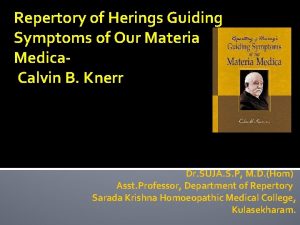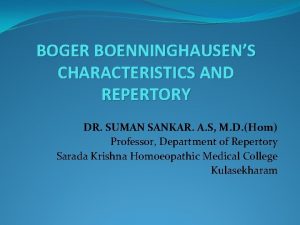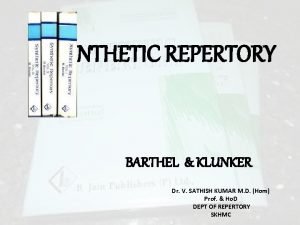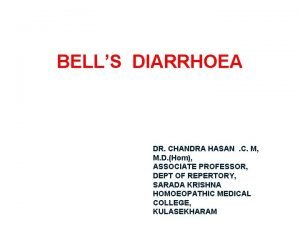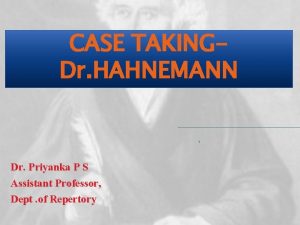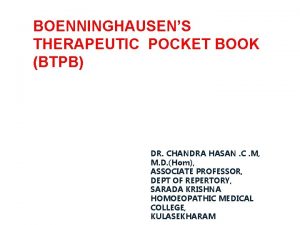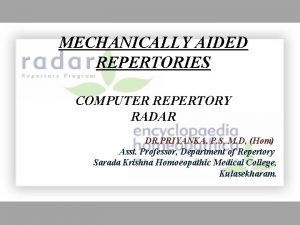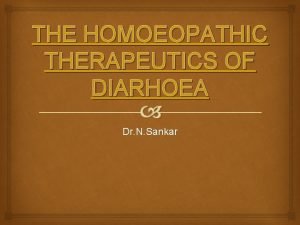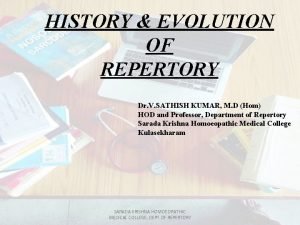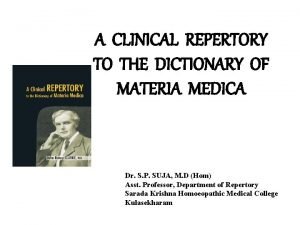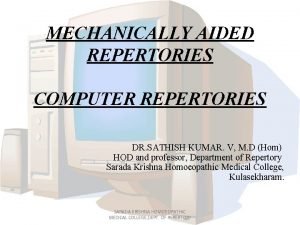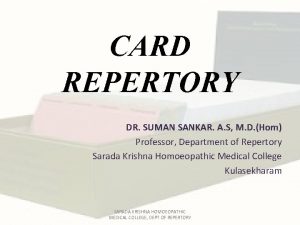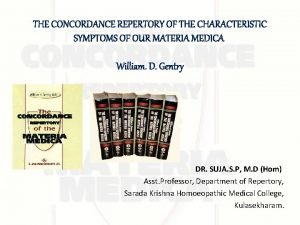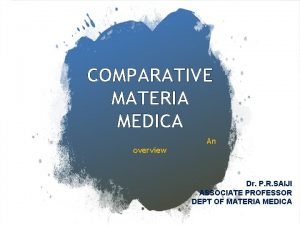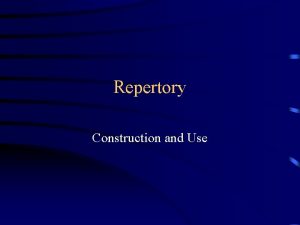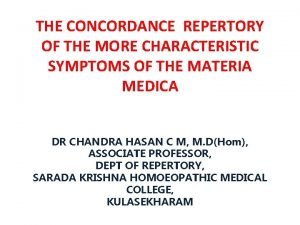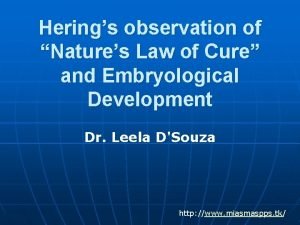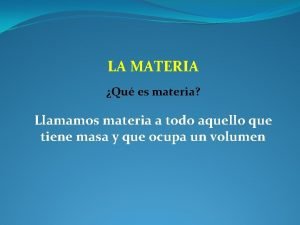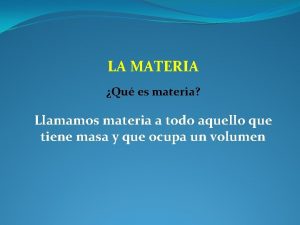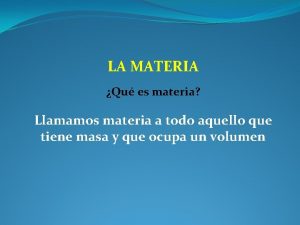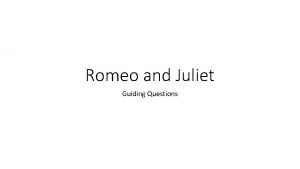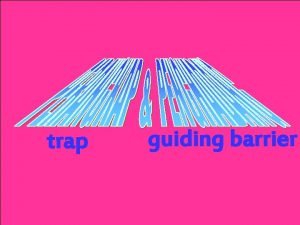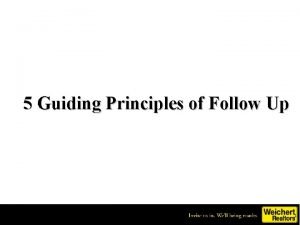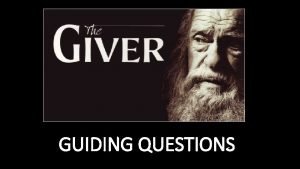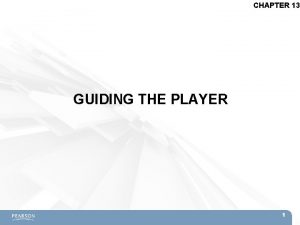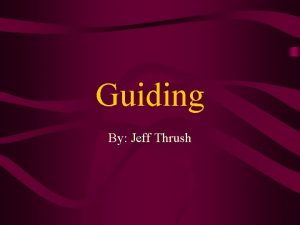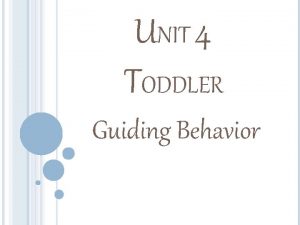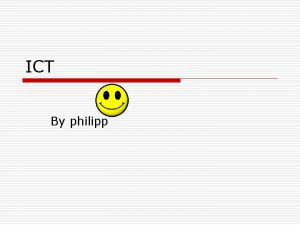Repertory of Herings Guiding Symptoms of Our Materia





























- Slides: 29

Repertory of Herings Guiding Symptoms of Our Materia Medica Calvin B. Knerr Dr. SUJA. S. P, M. D. (Hom) Asst. Professor, Department of Repertory Sarada Krishna Homoeopathic Medical College, Kulasekharam.

�Calvin Knerr was born December 27, 1847 and grew up with a father who was a lay homeopath and an uncle who knew Hering at the Allentown Academy. He attended The Allentown College Institute and graduated from Hahnemann Medical College in 1869 (along with Cowperthwaite and T. L. Bradford). �He then entered the office of Dr. Constantine Hering as his assistant. The diary he kept while living in Hering's house became The Life of Hering, published in 1940.

� From 1873 -4 Dr. Knerr studied in Berlin, Vienna, and London. In 1874 he married Melitta Hering, one of Hering's daughters, and resumed his duties as Hering's assistant. In 1878 and 1879 he published 2 editions of his book, Sunstroke and Its Homeopathic Treatment. � Upon Hering's death in 1880 Knerr became responsible for the completion of the 10 -volume Guiding Symptoms. Originally working with Dr. Charles Mohr and Dr. Charles Raue, and later working alone, Knerr completed Hering's masterpiece in 1895.

� Dr. Knerr spent 5 years writing his 2 -volume Repertory to the Guiding Symptoms, which was published in 1896. This repertory to Hering's materia medica never saw widespread use. � Knerr used the same structure throughout as found in the Guiding Symptoms, even to including the "relationships" at the end of the book and giving the remedies the four lines of grading. This makes for a book that is bulky without being that useful in everyday study. � As a reference repertory for comparative research it has its own place. Knerr's repertory mixes pathogenic and clinical data but it also contains rubrics that are found nowhere else. Now available on computer, the complexity and difficulty of Knerr's repertory have given way to ease of access through simple search functions.

�For a considerable length of time Knerr's repertory remained out of print. After a prolonged correspondence Dr. Knerr agreed to grant Messrs. M. Bhattacharyya and Co. the exclusive right of publication. He revised the whole work, portions of which he wrote anew for this edition.

� In the 1941 Homeopathic Herald memoriam Dr. W. A. Pearson writes, � "His home on Camac Street was filled with books, pictures and mementoes pertaining to homoeopathy. The original letters (1813 -1836) written to Constantine Hering by Samuel Hahnemann were probably the most prized possession. “ � "Several of these letters have been published in Hospital Tidings during the past year and afford much reliable information concerning Homoeopathy. Most of these historic treasures have been presented to The Hahnemann Medical College. "

�His was a life of unceasing work, and even when confined to bed he actually prescribed for his patients. He died on September 30, 1940. �To quote Pearson again, �"Dr. Knerr lived a long and useful life and we should rejoice that he fulfilled a very important mission so ably. "

Introduction �Author: Calvin B Knerr. M. D �Published By : Jain Publishing Co. �Year of publishing : 1896 �Based on : hering guiding symptoms of our MM �No of remedies : 408 ( in repertory) in drug relationship chapter 394 drug grugs relationship is mentioned( out of 415 remedies, under 10 remedies no observation given and 11 remedies only cross reference given, so excluding this chapter).

�While comparing with hering guiding symptoms the remedies which are missing in knerr repertory are : � 1. Citrus vugaris � 2. Iodoformum � 3. Uva ursi � 4. Eugenia jambosa

�Remedies that are present in knerr repertory but missing in guiding symptoms are : � 1. Aurantium � 2. Polyporu off. , Boletus laricis, Agaricus laricus � 3. Castoreum muscovitum � 4. Euphrasia off. � 5. Euphorbium � 6. Hydrocotyle � 7. Illicum anisatum

PREFACE : � The order of arrangement, followed in the compilation of this repertory is the one inaugurated by Hahnemann, developed, perfected and used by Hering through out his entire materia medica work viz. : the anatomical or regional division into 48 chapters. � Each chapter is alphabetically divided into sections and rubrics sufficient to allow full scope for analysis of the matter contained there in without destroying consistency as a whole. � The division of the page into double columns is deemed most convenient for the eye and is most advantageous to economy of space.

� The section word is repeated down the column in preference to the customary ----, which like all marks of abbreviation, ciphers, signs etc are apt to become confusing and are not as space saving as might be supposed. For eg : Chapter Nose - Coryza Acrid Coryza albuminous etc. The words right and left, better and worse etc, to avoid possible error, is printed out in full.

� The ' rubric word ' or heading to each paragraph, ( eg - Coryza Acrid : ) printed in somewhat bolder and blacker type and followed by a : ( colon ) applies to each symptom in the paragraph, that is the black letter word is to be mentally repeated for every sentence rounded with a semicolon. It will be observed that the symptoms under each rubric follow in alphabetic order. � Eg: Coryza Bloody : Act sp, 11 Ailan …… 1 sulp; when blowing 11 calad, carbo acid.

Gradation of remedies � There are four marks of distinction: - 1, 1 , 11 have the significance as set down in guiding symptoms. 1 -- the lowest, a single light line, designating an occasionally confirmed symptom 11 -- a double light line, a symptom more frequently confirmed, or if or but once confirmed strictly in character with the genius of the remedy. 1 -- a single heavy line, symptom verified by cures. 11 -- a double heavy line, symptom repeatedly verified These degree marks tallies in the main with the four styles of type used by Boenninghausen in his repertory.

Symbols used � θ -- the Greek "theta" standing between the cured symptom and the pathological condition, or the physiological general state, throughout the guiding symptom, is dispensed with there, mainly for the purpose of economizing space, by enclosing the pathological or physiological term in parenthesis; it is to be remembered that the presence of the term by no means shuts out the usefulness of the symptom in other forms of disease. . � Eg: Mind and disposition – (insanity), (hydrophobia) ---Page no : 17

�: -- the perpendicular dotted line , marks observation taken from the old school such as harmonize with our law of cure. �Eg : Nose – ozena : chrom. Ac --page no : 261

� t --- toxicological extracts Eg: Upper face – face, blue – bluish, pale: t. Agar---page no 279 �π --- symptom observed on the sick only. Eg : Mind and disposition – absent minded : π carb ac (p. no: 17)

�The hand direction cross reference to related symptoms, diseases and conditions. The repertory is supplemented by a complete index of localities and terms �Eg: page 375

�As in the guiding symptoms, so in the repertory; original readings, the words of the prover and the clinician are preserved to the letter, it being thought preferable to retain the most delicate shades of meaning, occasionally even different wordings of the same symptoms, by taking refuge in an extra rubric or cross reference, fuse or commingle in a vague generalization at the sacrifice of individuality.

� This repertory is a faithful reproduction of the guiding symptoms, its contents classified and indexed. But it can no way can take the place of the larger work. In a repertory , we have separation by analysis for the purpose of classification and ready reference; in materia medica combination by synthesis to enable us to study drug effects in their grand unity and relationship.

�Author also mentions his gratefulness to those who has helped him ti bring the work to completion. Especially to Dr, C Guernsey foe valuable assistance with proofs, to Dr. W. H. Phillip, Messrs, Douty, Ziegler, and Field, his son Bayard and others of his family foe clerical assistance; and lastly to his brother in law - Walter E Hering, under whose experienced and skillful management, aided by his old and reliable foreman Wm. Baetzel, the unusually difficult composition and press work have taken place.

Chapters : � 1. Mind and disposition. 2. Sensorium. 3. Inner head 4. Outer head. 5. Eyes. 6. Ears. 7. Nose. 8. Upper face. 9. Lower face. 10. Teeth and gums

� 11. Taste and tongue. 12. Inner mouth. 13. Throat. 14. Desires, aversions, appetite, thirst. 15. Eating and drinking. 16. Hiccough, belching, nausea and vomiting. 17. Scrobiculum and stomach. 18. Hypochondria. 19. Abdomen. 20. Stool and rectum. 21. Urinary organs. 22. Male sexual organs. 23. Female sexual organs. 24. Pregnancy, parturition, lactation. 25. Voice, larynx, trachea, bronchia.

� 26. Respiration. 27. Cough and expectoration. 28. Inner chest and lungs. 29. Heart, pulse and circulation. 30. Outer chest. 31. Neck and back. 32. Upper limbs. 33. Lower limbs. 34. Limbs in general. 35. Rest, position, motion. 36. Nerves. 37. Sleep. 38. Time.

� 39. Temperature and weather. 40. Fever. 41. Attacks, periodicity. 42. Locality and direction. 43. Sensations in general. 44. Tissues. 45. Touch, passive motion, injuries. 46. Skin. 47. Stages of life and constitution. 48. Drug relation ship.

MERITS � 1. Useful as a book of reference, to find the desired symptom together with the indicated remedy. 2. The symptoms are given in their original form without much change. 3. Symptoms arranged in alphabetical order under each chapter. 4. About 408 medicines are dealt within the repertory. 5. There are four grading of symptoms, which helps us to understand the relative importance of drugs in the concerned symptom. 6. Since the cross-reference is given, one symptom can be referred to at more than one place.

� 7. Additional chapters are given in this book, which are not found in any other book. For eg : Chapters - Pregnancy, parturition , lactation. Heart, pulse and circulation. Limbs in general. Rest, position, motion. Nerves. Time. Temperature and weather. Attacks, periodicity. Locality and direction. Tissues. Touch, passive motion , injuries. Stages of life and constitution.

DEMERITS � 1. This repertory is not useful for systematic repertorisation of a case. � 2. The abbreviations given for the medicines are different from other books.

THANK YOU
 Guiding symptoms meaning
Guiding symptoms meaning Sore boobs early pregnancy
Sore boobs early pregnancy Awareness of ourselves and our environment is
Awareness of ourselves and our environment is Our census our future
Our census our future Our awareness of ourselves and our environment
Our awareness of ourselves and our environment Christ, be our light
Christ, be our light Our life is what our thoughts make it
Our life is what our thoughts make it God our father christ our brother
God our father christ our brother Our awareness of ourselves and our environment
Our awareness of ourselves and our environment Marcus aurelius our life is what our thoughts make it
Marcus aurelius our life is what our thoughts make it Money-madness is written by
Money-madness is written by Thinking language and intelligence
Thinking language and intelligence Our future is in our hands quotes
Our future is in our hands quotes We bow our hearts
We bow our hearts Awareness of ourselves and our environment is
Awareness of ourselves and our environment is Our census our future
Our census our future Boger boenninghausen characteristic repertory
Boger boenninghausen characteristic repertory Dr klunker
Dr klunker Bell's diarrhoea repertory
Bell's diarrhoea repertory Conjoint malady in repertory
Conjoint malady in repertory Murphy repertory rubrics
Murphy repertory rubrics Btpb repertory
Btpb repertory Radar full form in repertory
Radar full form in repertory Bell's diarrhoea repertory
Bell's diarrhoea repertory First repertory was published by
First repertory was published by Rubric definition in repertory
Rubric definition in repertory Computer repertory
Computer repertory Sharma card repertory image
Sharma card repertory image Gentry repertory ppt
Gentry repertory ppt Potential differential field in repertory
Potential differential field in repertory
